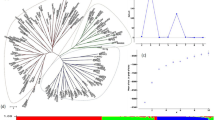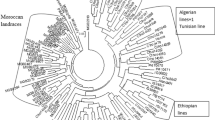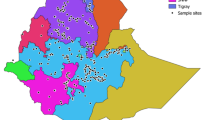Abstract
The pool of Western Mediterranean landraces has been under-utilised for barley breeding so far. The objectives of this study were to assess genetic diversity in a core collection of inbred lines derived from Spanish barley landraces to establish its relationship to barleys from other origins, and to correlate the distribution of diversity with geographical and climatic factors. To this end, 64 SSR were used to evaluate the polymorphism among 225 barley (Hordeum vulgare ssp. vulgare) genotypes, comprising two-row and six-row types. These included 159 landraces from the Spanish barley core collection (SBCC) plus 66 cultivars, mainly from European countries, as a reference set. Out of the 669 alleles generated, a large proportion of them were unique to the six-row Spanish barleys. An analysis of molecular variance revealed a clear genetic divergence between the six-row Spanish barleys and the reference cultivars, whereas this was not evident for the two-row barleys. A model-based clustering analysis identified an underlying population structure, consisting of four main populations for the whole genotype set, and suggested further possible subdivision within two of these populations. Most of the six-row Spanish landraces clustered into two groups that corresponded to geographic regions with contrasting environmental conditions. The existence of wide genetic diversity in Spanish germplasm, possibly related to adaptation to a broad range of environmental conditions, and its divergence from current European cultivars confirm its potential as a new resource for barley breeders, and make the SBCC a valuable tool for the study of adaptation in barley.




Similar content being viewed by others
References
Baek HJ, Beharav A, Nevo E (2003) Ecological-genomic diversity of microsatellites in wild barley, Hordeum spontaneum, populations in Jordan. Theor Appl Genet 106:397–410
Bassam B J, Caetano-Anolles G, Gresshoff P M (1991) Fast and sensitive silver staining of DNA in polyacrilamide gels. Anal Biochem 196:80–83
Baumer M, Cais R (2000) Abstammung der Gerstensorten. Ed. Bayerische Landesanstalt für BodenKultur und Pflanzenbau, 109 p
Briggs DE (1978) Barley. Chapman & Hall, London, pp 445–480
Casas AM, Igartua E, Vallés MP, Molina-Cano JL (1998) Genetic diversity of barley cultivars grown in Spain, estimated by RFLP, similarity and coancestry coefficients. Plant Breed 117:429–435
Casas AM, Yahiaoui S, Ciudad F, Igartua E (2005) Distribution of MWG699 polymorphism in Spanish European barleys. Genome 48:41–45
Chao S, Zhang W, Dubcovsky J, Sorrells M (2007) Evaluation of genetic diversity and genome-wide linkage disequilibrium among US wheat (Triticum aestivum L) germplasm representing different market classes. Crop Sci 47:1018–1030
Ellis RP, McNicol JW, Baird E, Booth A, Lawrence P, Powell W (1997) The use of AFLPs to examine genetic relatedness in barley. Mol Breed 3:359–369
Falush D, Stephens M, Pritchard JK (2003) Inference of population structure using multilocus genotype data: linked loci and correlated allele frequencies. Genetics 164:1567–1587
Fischbeck G (1992) Barley cultivar development in Europe—success in the past and possible changes in the future. In: Munck L (ed) Barley genetics VI, vol II. Munksgaard International Publishers Ltd, Copenhagen, pp 885–901
Garris AJ, McCouch SR, Kresovish S (2003) Population stucture and its effect on haplotype diversity and linkage disequilibrium surrounding the xa5 locus of rice (Oryza sativa L.). Genetics 165:759–769
Graner A, Ludwig WF, Melchinger AE (1994) Relationships among European barley germplasm: II. Comparison of RFLP and pedigree data. Crop Sci 34:1199–1205
Goldstein DB, Ruiz Linares A, Cavalli-Sforza LL, Feldman MW (1995) An evaluation of genetic distances for use with microsatellite loci. Genetics 139:463–471
Igartua E, Gracia MP, Lasa JM, Medina B, Molina-Cano JL, Montoya JL, Romagosa I (1998) The Spanish barley core collection. Genet Resour Crop Env 45:475–481
Ivandic V, Hackett CA, Nevo E, Keith R, Thomas WTB, Forster B (2002) Analysis of simple sequence repeats (SSRs) in wild barley from the Fertile Crescent: associations with ecology, geography and flowering time. Plant Mol Biol 48:511–527
Ivandic V, Thomas WTB, Nevo E, Zhang Z, Forster B (2003) Associations of simple sequence repeats with quantitative trait variation including biotic and abiotic stress tolerance in Hordeum spontaneum. Plant Breed 122:300–304
Jung M, Ching A, Bhattraramakki D, Dolan M, Tingey S, Morgante M, Rafalski A (2004) Linkage disequilibrium and sequence diversity in a 500-kbp region around the adh1 locus in elite maize germplasm. Theor Appl Genet 109:681–689
Karakousis A, Barr AR, Chalmers KJ, Ablett GA, Holton TA, Henry RJ, Lim P, Langridge P (2003) Potential of SSR markers for plant breeding and variety identification in Australian barley germplasme. Aust J Agric Res 54:1197–1210
Koebner RMD, Donini P, Reeves JC, Cooke RJ, Law JR (2003) Temporal flux in the morphological and molecular diversity of UK barley. Theor Appl Genet 106:550–558
Komatsuda T, Maxim P, Sentil N, Mano Y (2004) High-density AFLP map of nonbrittle rachis 1 (btr1) and (btr2) genes in barley (Hordeum vulgare L.). Theor Appl Genet 109:986–995
Kraakman ATW, Niks RE, Van der Berg PMMM, Stam P, Van Eeuwijk FA (2004) Linkage disequilibrium mapping of yield and yield stability in modern spring barley cultivars. Genetics 168:435–446
Lasa JM, Igartua E, Ciudad FJ, Codesal P, García EV, Gracia MP, Medina B, Romagosa I, Molina-Cano JL, Montoya JL (2001) Morphological and agronomical diversity patterns in the Spanish barley core collection. Hereditas 135:217–225
Macaulay M, Ramsay L, Powell W, Waugh R (2001) A representative, highly informative ‘genotyping set’ of barley SSRs. Theor Appl Genet 102:801–809
Maestri E, Malcevschi A, Massari A, Marmiroli N (2002) Genomic analysis of cultivated barley (Hordeum vulgare) using sequence-tagged molecular markers. Estimates of divergence based on RFLP and PCR markers derived from stress-responsive genes, and simple-sequence repeats (SSRs). Mol Genet Genomics 267:186–201
Malysheva-Otto LV, Ganal MW, Röder MS (2006) Analysis of molecular diversity, population structure and linkage disequilibrium in worldwide cultivated barley germplasm (Hordeum vulgare L.). BMC Genetics 7:6–19
Matus IA, Hayes PM (2002) Genetic diversity in three groups of barley germplasm assessed by simple sequence repeats. Genome 45:1095–1106
Melchinger AE, Graner A, Singh M, Messmer MM (1994) Relationships among European barley germplasm: I. Genetic diversity among winter and spring cultivars revealed by RFLPs. Crop Sci 34:1191–1199
Molina-Cano JL, Fra-Mon P, Salcedo G, Aragoncillo C, Roca de Togores F, García-Olmedo F (1987) Morocco as a possible center for barley: biochemical and agromorphological evidence. Theor Appl Genet 98:913–918
Molina-Cano JL, Russell JR, Moralejo MA, Escacena JL, Arias G, Powell W (2005) Chloroplast DNA microsatellite analysis supports a polyphyletic origin for barley. Theor Appl Genet 110:613–619
Moralejo M, Romagosa I, Salcedo G, Sànchez-Monge R, Molina-Cano JL (1994) On the origin of Spanish two-rowed barleys. Theor Appl Genet 87:829–836
Morrell PL, Clegg MT (2007) Genetic evidence for a second domestication of barley (Hordeum vulgare) east of the Fertile Crescent. PNAS 104:3289–3294
Morris ML, Belaid A, Byerlee D (1991) Wheat and barley production in rainfed marginal environments of the developing world. Part 1 of 1990–91 CIMMYT world wheat facts and trends: wheat and barley production in rainfed marginal environments of the developing world.CIMMYT, Mexico
Nei M (1973) Analysis of gene diversity in subdivided populations. Proc Natl Acad Sci USA 70:3321–3323
Nevo E, Beharav A, Meyer RC, Hackett CA, Forster BP, Russell JR, Powell W (2005) Genomic microsatellite adaptive divergence of wild barley by microclimatic stress in ‘Evolution Canyon’, Israel. Biol J Linn Soc 84:205–224
Olsen KM, Halldorsdottir SS, Stinchcombe JR, Weining C, Schmitt J Purugganan MD (2004) Linkage disequilibrium mapping of Arapidosis CRY2 flowering times alleles. Genetics 167:1361–1369
Orabi J, Backes G, Wolday A, Yahyaoui A, Jahoor A (2007) The Horn of Africa as a centre of barley diversification and a potential domestication site. Theor Appl Genet 114:1117–1127
Pandey M, Wagner C, Friedt W, Ordon F (2006) Genetic relatedness and population differentiation of Himalayan hulless barley (Hordeum vulgare L.) landraces inferred with SSRs. 167:1361–1369. Theor Appl Genet 113:715–729
Papadakis J (1975) Climates of the world and their agricultural potentialities. Edición Argentina, Buenos Aires, 200 pp
Pillen K, Binder A, Kreuzkam B, Ramsay L, Waugh R, Förster J, Léon J (2000) Mapping new EMBL-derived barley microsatellites and their use in differentiating German barley cultivars. Theor Appl Genet 101:652–660
Ramsay L, Macaulay M, degli Ivanissevich S, MacLean K, Cardle L, Fuller J, Edwards KJ, Tuvesson S, Morgante M, Massari A, Maestri E, Marmiroli N, Sjakste T, Ganal M, Powell W, Waugh R (2000) A simple sequence repeat-based linkage map of barley. Genetics 156:1997–2005
Remington DL, Thornsberry JM, Matsuoka Y, Wilson LM, Whitt SR, Doebley J, Kresovich S, Goodman MM, Buckler IV ES (2001) Structure of linkage disequilibrium and phenotypic associations in the Maize genome. Proc Natl Acad Sci USA 98:11479–11484
Rohlf FJ (2000) NTSYSpc, numerical taxonomy and multivariate analysis system, version 2.1. Exeter Software, New York
Ruimy A, Dedieu G, Saugier B (1996) TURC: a diagnostic model of continental gross primary productivity and net primary productivity. Global Biogeochem Cycles 10(2):269–285
Russell J, Fuller J, Young G, Thomas B, Taramino G, Macaulay M, Waugh R, Powell W (1997) Discriminating between barley genotypes using microsatellite markers. Genome 40:442–450
Russell JR, Ellis RP, Thomas WTB, Waugh R, Provan J, Booth A, Fuller J, Lawrence P, Young G, Powell W (2000) A retrospective analysis of spring barley germplasm development from ‘foundation genotypes’ to currently successful cultivars. Mol Breed 6:553–568
Russell JR, Fuller J, Baum M, Ceccarelli S, Grando S, Powell W (2003) Patterns of polymorphism detected in the chloroplast and nuclear genomes of barley landraces samples from Syria and Jordan. Theor Appl Genet 107:413–421
SAS Institute (1988) SAS/STATTM user’s guide, release 6.03, edition. SAS Institute Inc., Cary, 1028 p
Schneider S, Roessli D, Excoffier L (2000) Arlequin v. 2.000. A software for population genetic data analysis. Genetics and Biometry Laboratory. University of Geneva, Switzerland
Sjakste TG, Rashal I, Röder MS (2003) Inheritance of microsatellite alleles in pedigrees of Latvian barley varieties and related European ancestors. Theor Appl Genet 106:539–549
Struss D, Plieske J (1998) The use of microsatellite for detection genetic diversity in barley populations. Theor Appl Genet 97:308–315
Tanno K, Takaiwa F, Oka S, Komatsuda T (1999) A nucleotide sequence linked to the vrs1 locus for studies of differentiation in cultivated barley (Hordeum vulgare L.). Heriditas 130:77–82
Tanno K, Taketa S, Takeda K, Komatsuda T (2002) A DNA marker closely linked to the vrs 1 locus (row type gene) indicates multiple origins of six rowed cultivated barley. (Hordeum vulgare L.). Theor Appl Genet 104:54–60
Turpeinen T, Tenhola T, Manninen O, Nevo E, Nissilä E (2001) Microsatellite diversity associated with ecological factors in Hordeum spontaneum populations in Israel. Mol Ecol 10:1577–1591
Acknowledgments
This research was funded by project RTA01-088-C3, granted by the Instituto Nacional de Investigación y Tecnología Agraria y Alimentación (INIA), of the Spanish Ministry of Science and Technology, and co-funded by the European Regional Development Fund. Samia Yahiaoui was supported by a scholarship from the Agencia Española de Cooperación Internacional (AECI), of the Spanish Ministry of Foreign Affairs.
Author information
Authors and Affiliations
Corresponding author
Additional information
Communicated by J. Yu.
Electronic supplementary material
Below is the link to the electronic supplementary material.
Rights and permissions
About this article
Cite this article
Yahiaoui, S., Igartua, E., Moralejo, M. et al. Patterns of genetic and eco-geographical diversity in Spanish barleys. Theor Appl Genet 116, 271–282 (2008). https://doi.org/10.1007/s00122-007-0665-3
Received:
Accepted:
Published:
Issue Date:
DOI: https://doi.org/10.1007/s00122-007-0665-3




